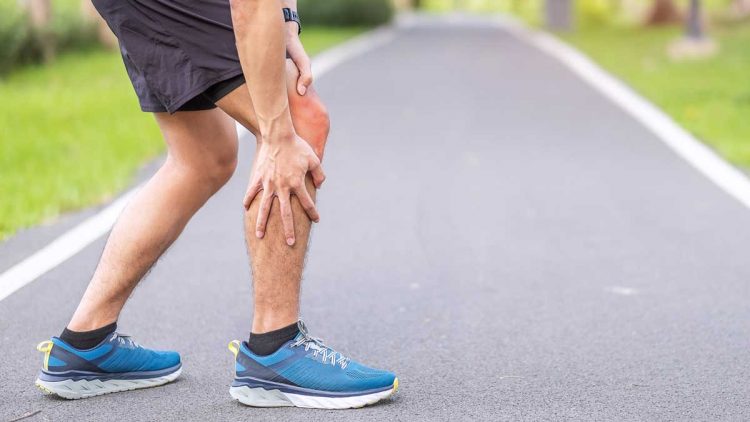Running is a fantastic way to stay fit, improve cardiovascular health, and boost mental well-being. However, many runners experience knee pain, which can hinder performance and lead to long-term injuries. If you want to keep your knees healthy and prevent discomfort, it’s essential to take the right precautions.
In this guide, we’ll explore why knee pain occurs while running and provide practical tips to prevent it so you can enjoy pain-free runs.
Why Does Knee Pain Occur When Running?

Knee pain while running can result from several factors, including:
- Overuse or high-impact stress – Repetitive pounding on hard surfaces can strain knee joints.
- Weak muscles – Insufficient strength in the quadriceps, hamstrings, and glutes can lead to poor knee support.
- Poor running form – Incorrect posture or gait can increase stress on the knees.
- Worn-out shoes – Lack of proper cushioning and support may contribute to knee pain.
- Tight muscles – Stiff hamstrings, calves, and hip flexors can alter knee mechanics, causing strain.
- Underlying conditions – Issues like runner’s knee, patellar tendonitis, or arthritis can lead to knee discomfort.
How to Prevent Knee Pain When Running
1. Warm Up Properly
Starting a run with cold muscles increases the risk of knee pain and injuries. Always perform a 5–10 minute warm-up before running. Try:
- Light jogging or brisk walking
- Dynamic stretches like leg swings and high knees
- Hip and knee mobility exercises
2. Strengthen Your Leg Muscles
Strong leg muscles provide better knee support and absorb impact efficiently. Focus on exercises that target:
- Quadriceps – Squats, lunges, and leg presses
- Hamstrings – Deadlifts and hamstring curls
- Glutes – Bridges and hip thrusts
- Calves – Calf raises for better shock absorption
3. Improve Your Running Form
Poor form places unnecessary stress on the knees. Follow these key running techniques:
- Land midfoot rather than on your heels or toes
- Keep your knees slightly bent while landing to absorb shock
- Maintain an upright posture and engage your core
- Avoid overstriding – keep your steps short and efficient
4. Wear Proper Running Shoes
Choosing the right footwear reduces knee strain. Consider:
- Running shoes with good arch support and cushioning
- Shoes suited to your foot type (neutral, overpronation, or underpronation)
- Replacing shoes every 300–500 miles to maintain support
5. Run on Softer Surfaces
Running on hard surfaces like concrete increases knee impact. Try switching to:
- Grass or dirt trails
- Treadmills with shock absorption
- Tracks designed for running
6. Maintain a Healthy Weight
Excess weight puts extra pressure on the knees. Maintaining a healthy BMI can help reduce knee strain and improve overall running performance.
7. Stretch and Cool Down After Running
Stretching keeps your muscles flexible and prevents tightness that can lead to knee pain. After your run, focus on stretching:
- Quadriceps
- Hamstrings
- Calves
- Hip flexors
8. Increase Mileage Gradually
Avoid sudden increases in running intensity or distance. Follow the 10% rule – increase your weekly mileage by no more than 10% to prevent overuse injuries.
9. Use Knee Braces or Supportive Gear
If you’re prone to knee pain, wearing a knee brace or compression sleeve can provide added support and stability while running.
10. Listen to Your Body
If you feel knee discomfort while running, stop and rest. Running through pain can lead to serious injuries. If pain persists, consult a healthcare professional.
Also Read: Knee Brace For Sciatica Nerve Pain – Does It Really Help?
When to See a Doctor
If you experience:
- Persistent or worsening knee pain
- Swelling, redness, or stiffness
- Pain that interferes with daily activities
- A popping or locking sensation in the knee
Seek medical attention to rule out any serious conditions.
FAQ’s
1. Why do my knees hurt when I run?
Knee pain while running is often caused by overuse, weak muscles, poor running form, worn-out shoes, or underlying conditions like runner’s knee or arthritis.
2. How can I prevent knee pain before running?
Warming up with dynamic stretches, light jogging, and mobility exercises can prepare your muscles and joints, reducing the risk of knee pain.
3. What are the best exercises to strengthen my knees for running?
Squats, lunges, deadlifts, calf raises, and bridges help strengthen the quadriceps, hamstrings, and glutes, providing better knee support.
4. How do running shoes affect knee pain?
Wearing proper running shoes with good arch support and cushioning helps absorb impact and reduces strain on the knees. Replacing shoes every 300–500 miles is recommended.
5. Is it better to run on grass or pavement?
Softer surfaces like grass, dirt trails, and tracks reduce impact on the knees compared to hard surfaces like concrete or asphalt.
6. Should I wear a knee brace while running?
If you’re prone to knee pain, a knee brace or compression sleeve can provide extra support and stability while running.
7. How can I increase my running distance without knee pain?
Follow the 10% rule—gradually increase your mileage by no more than 10% per week to prevent overuse injuries.
8. When should I see a doctor for knee pain?
Seek medical attention if you experience persistent or worsening pain, swelling, stiffness, or a popping/locking sensation in your knee.
Final Thoughts
Knee pain doesn’t have to be a part of your running routine. By warming up, strengthening your muscles, improving form, wearing proper shoes, and listening to your body, you can prevent knee pain and enjoy long-term running success. Take proactive steps today and keep your knees healthy for the miles ahead!
Related Post
- Zimatejigemo – Unlocking the Fusion of Creativity, Identity, and Innovation!
- Tinaypimatelate – The Revolutionary Concept Shaping the Future of Innovation!
- Limhuloxidpov – A Complete Guide to Understanding This Unique Concept!
- Zaxtexporoz – Exploring the Emerging Concept of Innovation and Digital Transformation!
- Lekulent – The Breakthrough Wellness Solution Taking the Health World by Storm!






